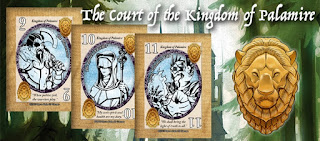Hey guys. Exactly one week from today I'll be done with the first of the professional certification exams I have slated for this year. While more exams will be forthcoming, there'll be a bit of a break between sitting for the exam and receiving my results, during which I hope to get reacquainted with...well...everything really.
In the meantime, meet the guys behind Move Rate 20 Games, the minds behind the nimble-but-intrinsically-strategic card game, Master of Spies.
 |
| Image Credit |
Tell us a little about yourselves. What prompted you to want to become game developers?
We’re a group of friends who’ve played various games together for years. We wanted to take our love of gaming to the next level and that was developing our own games. Steve R. brought an idea for a game he had to us, and we agreed to help him develop it -- that game is still being built out. Steve P. showed the group another quick, fun game idea he had, and that eventually became ourfirst Kickstarter, Master of Spies.
Once you decided to put on the developer’s hat, what made you choose this specific type of game? Why did you feel a card-based game was a particularly good fit for your vision of Master of Spies?
Master of Spies was, like many things in life, developed out of frustration. While working on developing our first game idea, which has the working title of “Project Lightning Sword,” Stephen P. got frustrated with some game-mechanic roadblocks. To clear his mind, he sat at the kitchen table with a deck of cards and some poker chips and came up with the rough idea for a simple, quick game that became Master of Spies. We then took that initial idea, tweaked it a bit and decided that it would be a good first release as it had appeal to both hard-core and more casual gamers alike. During the development, we got the idea of tying all of our games together by setting them within the Eldinar universe and thought that using the spy theme would be a fun introduction to the world.
The game is touted as being extremely easy to learn, but a highly satisfying overall play experience. How long would you say it takes people to pick up Master of Spies and what demographics do you think would most enjoy the game?
The basics of the game are very easy to learn, children as young as age nine have gotten the basics in just one play-through. The advanced rules add a bit more strategy, but gameplay remains quick & easy to learn. We believe the game would appeal to families with players of different ages & skill levels since, while being easy to learn, it also has enough strategy to keep the attention of more serious gamers.
The puzzle-based game market is pretty competitive with both major publishers and Indie developers in the field. What would you say makes Master of Spies distinct?
Well, one of the things that make it unique is that it’s based around the world of Eldinar, a unique fantasy world we are creating for the majority of our games. The names of places and characters will appear again and again, taking players deeper and deeper into the intrigue of the world. Plus, there’s the scalable complexity of the game -- we’ve designed it with rules for a “basic” game and a set of Advanced Rules with “Special Actions” that can further a player’s advantage or thwart an opponent.
The artwork and overall aesthetic of the game is very interesting. What was your inspiration for the look and feel of the game?
Since the world of Eldinar is a fantasy realm, we wanted the cards to have a look that fit that universe -- cards that feel like they could exist in that world. I wanted something that looked good, was distinctive enough for each Faction, while also being easy to read.
 |
| Image Credit |
What do you feel was the most enjoyable part of developing Master of Spies and, conversely, what would you say was your biggest challenge?
The most enjoyable part was definitely seeing the reactions of people who play tested the game. They were initially engaged by it, but then got even more into it when they realized it offered more strategy than at first glance. The biggest challenge was finding a balance between simplicity and ease of play vs. depth and strategy, all while keeping gameplay short.
The most fun for me (Stephen P.), as the graphics guy, was designing the cards and bringing the artists onboard to create the portraits of the Royal Courts’ dignitaries.
You intimate on the Kickstarter page that the game would be the first in your Eldinar series, any hints as to what the rest of the series would be like?
The other game currently in development (Project: Lightning Sword) is a more complex resource management, unconventional deck building, and castle defense style card game. There are also plans for a board game and an RPG game setting, both also based in Eldinar.
Is there anything else that you think potential players should know about Master of Spies?
It is quick and fun…easy to learn….good for the family or for your hard-core gaming pals.
Collectively, we have played the game 100’s of times, for play testing, demoing at cons, showing family members during the holidays, etc., and we still enjoy playing. Every game is different because the tactics and styles of the different players combined with the randomness of the cards makes each game session different. Plus with no “player elimination” mechanic, everyone is still in the game and, with a cleverly played card, could potentially pull off a win in the last round.
Interested? The Kickstarter for Master of Spies runs for another two weeks; head over to their page for play footage and even more details!






